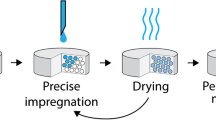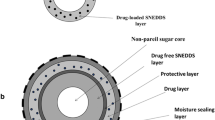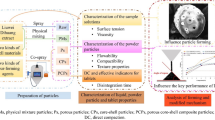Abstract
FDA-approved self-emulsifying medicines rely on liquid-based formulations, which can exhibit limited stability and short shelf-lives. Solid self-emulsifying drug delivery systems (SEDDS) can improve such issues, but there is still a great need for identifying suitable porous carriers to convert liquid SEDDS into solids without impairing their mechanical properties, functionality, and industrial feasibility. The impact of SEDDS adsorption on tableting is also poorly understood. Therefore, solid SEDDS were prepared by adsorbing liquid SEDDS onto ten commercially available porous excipients. Products were assessed with respect to mechanical behavior, tabletability, and product performance. Adsorbing SEDDS onto porous excipients led to satisfactory stability, with the exception of Zeopharm® 600 due to its high alkalinity, and Neusilin® US2/UFL2, which caused quercetin to crystallize out of the liquid concentrate. SEDDS adsorption reduced the elastic recovery of most excipients, making tableting achievable using Aeroperl® 300 and Aerosil® 200/300. The impact of SEDDS on elastic recovery provides additional understanding on solid SEDDS manufacture process. Acceptable tablets were made via direct compression but with slow disintegration. Addition of a superdisintegrant (crospovidone 5% w/w) ensured tablet manufacturing without impairment of product performance. Solid SEDDS displayed several technical advantages over their liquid counterparts, but attention must be given to the properties of the porous excipient chosen. Drug-excipient interactions play a significant role in drug degradation and crystallization in solid SEDDS. Improved mechanical behavior upon adsorption led to well-composed tablets that performed satisfactorily in vitro upon addition of a superdisintegrant. This study provides an insight on excipient-oriented rational development of solid SEDDS.








Similar content being viewed by others
References
Agrawal U, Sharma R, Gupta M, Vyas SP. Is nanotechnology a boon for oral drug delivery? Drug Discov Today. 2014;19(10):1530–46.
Fatouros DG, Müllertz A. Development of self-emulsifying drug delivery systems (SEDDS) for oral bioavailability enhancement of poorly soluble drugs. In: Drug delivery strategies for poorly water-soluble drugs. Oxford: Wiley; 2013. p. 225–45.
Tran TH, Guo Y, Song D, Bruno RS, Lu X. Quercetin-containing self-nanoemulsifying drug delivery system for improving oral bioavailability. J Pharm Sci. 2014;103(3):840–52.
Elgart A, Cherniakov I, Aldouby Y, Domb AJ, Hoffman A. Improved oral bioavailability of BCS class 2 compounds by self nano-emulsifying drug delivery systems (SNEDDS): the underlying mechanisms for Amiodarone and Talinolol. Pharm Res. 2013;30(12):3029–44.
Wang L, Dong J, Chen J, Eastoe J, Li X. Design and optimization of a new self-nanoemulsifying drug delivery system. J Colloid Interface Sci. 2009;330(2):443–8.
Tang B, Cheng G, Gu J-C, Xu C-H. Development of solid self-emulsifying drug delivery systems: preparation techniques and dosage forms. Drug Discov Today. 2008;13(13–14):606–12.
Savla R, Browne J, Plassat V, Wasan KM, Wasan EK. Review and analysis of FDA approved drugs using lipid-based formulations. Drug Dev Ind Pharm. 2017;43(11):1743–58.
Jing B, Wang Z, Yang R, Zheng X, Zhao J, Tang S, et al. Enhanced oral bioavailability of felodipine by novel solid self-microemulsifying tablets. Drug Dev Ind Pharm. 2016;42(3):506–12.
Ito Y, Kusawake T, Ishida M, Tawa R, Shibata N, Takada K. Oral solid gentamicin preparation using emulsifier and adsorbent. J Control Release. 2005;105(1–2):23–31.
Nazzal S, Khan MA. Controlled release of a self-emulsifying formulation from a tablet dosage form: stability assessment and optimization of some processing parameters. Int J Pharm. 2006;315(1–2):110–21.
Jannin V, Musakhanian J, Marchaud D. Approaches for the development of solid and semi-solid lipid-based formulations. Adv Drug Deliv Rev. 2008;60:734–46.
Weerapol Y, Limmatvapirat S, Jansakul C, Takeuchi H, Sriamornsak P. Enhanced dissolution and oral bioavailability of nifedipine by spontaneous emulsifying powders: effect of solid carriers and dietary state. Eur J Pharm Biopharm. 2015;91:25–34.
Kutza C, Metz H, Kutza J, Syrowatka F, Mäder K. Toward a detailed characterization of oil adsorbates as “solid liquids”. Eur J Pharm Biopharm. 2013;84(1):172–82.
Gumaste SG, Dalrymple DM, Serajuddin ATM. Development of solid SEDDS, V: compaction and drug release properties of tablets prepared by adsorbing lipid-based formulations onto Neusilin® US2. Pharm Res. 2013;30(12):3186–99.
Nasr A, Gardouh A, Ghorab M. Novel solid self-Nanoemulsifying drug delivery system (S-SNEDDS) for oral delivery of Olmesartan Medoxomil: design, formulation, pharmacokinetic and bioavailability evaluation. Pharmaceutics. 2016;8(4):20.
Shazly G, Mohsin K. Dissolution improvement of solid self-emulsifying drug delivery systems of fenofibrate using an inorganic high surface adsorption material. Acta Pharma. 2015;65(1):29–42.
Wang W, Zhang J, Wang S, Zhang H, Yang H, Yue G. Experimental study on the angle of repose of pulverized coal. Particuology. 2010;8:482–5.
Scalia S, Trotta V, Traini D, Young PM, Sticozzi C, Cervellati F, et al. Incorporation of quercetin in respirable lipid microparticles: effect on stability and cellular uptake on A549 pulmonary alveolar epithelial cells. Colloids Surf B: Biointerfaces. 2013;112:322–9.
USP 39/NF 34 The United States Pharmacopeia. Rockville, MD: the United States Pharmacopoeial convention; 2016.
Joshi AB, Patel S, Kaushal AM, Bansal AK. Compaction studies of alternate solid forms of celecoxib. Adv Powder Technol. 2010;21(4):452–60.
Kudryavtsev YV, Gelinck E, Fischer HR. Theoretical investigation of van der Waals forces between solid surfaces at nanoscales. Surf Sci. 2009;603(16):2580–7.
Okada T, Kobari H, Haeiwa T. Effects of fluoride and urea on the crystal growth of a hectorite-like layered silicate on a silica surface. Appl Clay Sci. 2016;132:320–5.
Pawar P, Joo H, Callegari G, Drazer G, Cuitino AM, Muzzio FJ. The effect of mechanical strain on properties of lubricated tablets compacted at different pressures. Powder Technol. 2016;301:657–64.
Tye CK, Sun CC, Amidon GE. Evaluation of the effects of tableting speed on the relationships between compaction pressure, tablet tensile strength, and tablet solid fraction. J Pharm Sci. 2005;94(3):465–72.
Dall’Acqua S, Miolo G, Innocenti G, Caffieri S. The photodegradation of quercetin: relation to oxidation. Molecules. 2012;17(12):8898–907.
Álvarez-Diduk R, Ramírez-Silva MT, Galano A, Merkoçi A. Deprotonation mechanism and acidity constants in aqueous solution of Flavonols: a combined experimental and theoretical study. J Phys Chem B. 2013;117(41):12347–59.
Catauro M, Papale F, Bollino F, Piccolella S, Marciano S, Nocera P, et al. Silica/quercetin sol-gel hybrids as antioxidant dental implant materials. Sci Technol Adv Mater. 2015;16(3):35001.
Berlier G, Gastaldi L, Ugazio E, Miletto I, Iliade P, Sapino S. Stabilization of quercetin flavonoid in MCM-41 mesoporous silica: positive effect of surface functionalization. J Colloid Interface Sci. 2013;393:109–18.
Krupa A, Jachowicz R, Kurek M, Figiel W, Kwiecień M. Preparation of solid self-emulsifying drug delivery systems using magnesium aluminometasilicates and fluid-bed coating process. Powder Technol. 2014;266:329–39.
Wu C-Y, Hancock BC, Mills A, Bentham AC, Best SM, Elliott JA. Numerical and experimental investigation of capping mechanisms during pharmaceutical tablet compaction. Powder Technol. 2008;181(2):121–9.
Picker KM. Time dependence of elastic recovery for characterization of tableting materials. Pharm Dev Technol. 2001;6(1):61–70.
Nazzal S, Nutan M, Palamakula A, Shah R, Zaghloul A, Khan M. Optimization of a self-nanoemulsified tablet dosage form of ubiquinone using response surface methodology: effect of formulation ingredients. Int J Pharm. 2002;240(1):103–14.
Cirri M, Roghi A, Valleri M, Mura P. Development and characterization of fast-dissolving tablet formulations of glyburide based on solid self-microemulsifying systems. Eur J Pharm Biopharm. 2016;104:19–29.
Acknowledgments
This research was funded by the Dane O. Kildsig Center for Pharmaceutical Processing Research (CPPR). The authors express their appreciation to the industrial advisor Dr. Jonathan Booth (AstraZeneca) for his valuable input and knowledge, and Sterling Glass for his assistance proof-reading this article. The University of Connecticut and AbbVie jointly participated in study design, research, data collection, analysis and interpretation of data, writing, reviewing, and approving the publication.
Author information
Authors and Affiliations
Corresponding author
Ethics declarations
Conflict of Interest
André O'Reilly Beringhs and Bruna Cristina Minatovicz are graduate students at the University of Connecticut; Bodhisattwa Chaudhuri and Xiuling Lu and professors at the University of Connecticut. They all have no additional conflicts of interest to report. Geoff G. Z. Zhang is an employee of AbbVie and may own AbbVie stock.
Rights and permissions
About this article
Cite this article
Beringhs, A.O., Minatovicz, B.C., Zhang, G.G.Z. et al. Impact of Porous Excipients on the Manufacturability and Product Performance of Solid Self-Emulsifying Drug Delivery Systems. AAPS PharmSciTech 19, 3298–3310 (2018). https://doi.org/10.1208/s12249-018-1178-x
Received:
Accepted:
Published:
Issue Date:
DOI: https://doi.org/10.1208/s12249-018-1178-x




